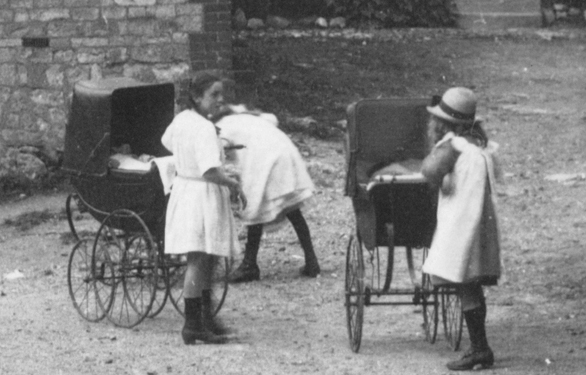Some family members fell upon hard times. Widowed in 1883 (Charles (Jnr) died at the age of 47), Hannah is listed by Reverend Gedge amongst the deserving poor in receipt of parish benefits and Poor Law relief in 1889. She had taken in lodgers by 1891 and all daughters but her youngest had left home, presumably for a life in service.
During the Great War (1914-1919), the Harfield family sent more of its members – ten – to fight than any other village family. (Although only seven Harfields are recorded on the Buriton Parish Roll of Honour displayed in the village hall.) Some family members were already serving as regular soldiers when war was declared.
Douglas (1889-1967), second son of James Harfield (1863-1933) and Alice Porter (and so a grandson of James and Sarah), was serving in the 1st Battalion, Dorsetshire Regiment, having enlisted in the Hampshire Regiment (purporting to be 17 when he was actually only 16) in December 1905. For reasons unrecorded in his Service Record, he transferred to the Dorsetshire Regiment in June 1906.
The Battalion War Diary records that Douglas deployed to France on 14th August 1914. Having retreated from Mons, the 1st Dorsets then fought at Ypres 1 (19th Oct – 22nd Nov 1914) and Ypres 2 (22nd April – 15th May 1915); defended the notorious Hill 60 when battalion gas casualties, orderlies and cooks were pressed into service to help keep the Germans the other side of a make-shift barricade placed across the trench the opposing armies now shared (July 1915); were slaughtered by machine gun fire in the second wave at the Somme before they even crossed into No Man’s land (July 1916); and resisted the German counter-attack in Operation Michael (April 1918). The battalion then fought in the conclusive battle of St Quentin Canal (29th Sept – 10th Oct 1918). The 1st Dorsets on occasions suffered casualties so heavy that the battalion was rendered non-operational until replacements could be supplied and trained. As far as is known, Douglas suffered no lasting physical injury despite repeatedly being shelled and gassed. It seems inconceivable that he would not have had appalling memories of his experiences.
Following the Armistice, Douglas and the 1st Dorsets were deployed to Germany as part of the Army of Occupation.
Douglas’s elder brother, Godfrey James Harfield (1887-1917) had also served as a Regular Soldier before the war. But by August 1914 he was a Territorial Force reservist serving in G Company, the Petersfield company of the 6th Battalion, Hampshire Regt. Volunteering for overseas service, Godfrey shipped to India in October 1914, the 1/6th Hants being sent there to guard the colony and so allow the 2nd Battalion Hampshire Regiment (regular soldiers) to return to Britain and prepare for deplpoyment to Gallipoli.
Having completed his contracted years of reservist service, Godfrey was demobilised with a honourable discharge in May 1916, re-patriated, and promptly re-enlisted – or was conscripted – for the Western Front. Assigned to the 7th Battalion, South Lancashire Regt., he was killed in action at Passchendaele on Tuesday 31st July 1917. His remains are amongst the many thousands that have never been identified or else not recovered and he is remembered on the Menin Gate memorial and the village memorial.
Both Godfrey and Douglas played football for Petersfield United.
Their younger brother, John (1892-1966), was also a regular soldier in 1914, serving with the 3rd Battalion Hampshire Regiment (in 1911 he was a 17 yr-old, unmarried soldier living in barracks). He was not deployed to France until the beginning of 1917, when he transferred to the 11th Hants, and later the 2nd Hants.
Their uncle, also named John (1870-1944), the sixth child and fourth son of James and Sarah, was also a Territorial when war broke out having previously been a regular soldier who saw action in the Boer War from November 1899 to September 1902 (in which, coincidentally he also served in the South Lancashire Regt.). Although a Territorial with the 6th Battalion, Hants Regt., when embodied back into the regular army the day after war broke out he was transferred to the Royal Engineers, serving in France from June 1917 until July 1919.
Alfred (1881-1953), the youngest of James and Sarah’s sons served in the 4th Battalion, Hampshire Regt, allocated a service number that indicates he enlisted in September 1914. He fought with the battalion in the Mesopotamian theatre of war.
The sons of David Harfield and Frances Gamblen, cousins to Godfrey, Douglas and John, and grandsons of James and Sarah, had mixed experiences during the Great War. The eldest, Herbert (b 1881), was already a Royal Navy dockyard worker in Portsmouth in 1914, a reserved occupation in which he continued until dying of natural causes in 1941.
Bernard (1883-1965), the second eldest, left Buriton in 1907, shortly after marrying Catherine Bird (1888-1961) at Buriton in April, to work on a farm in Cornwall, but returned to the village in October 1915 at the request of Lothian Bonham-Carter to work on the manor farm, which had lost many of its workers to the military. (It seems likely that Bernard and his family had returned to Hampshire, at least, sometime in 1911 but not immediately to Buriton.) Bernard suffered a congenital heart condition that rendered him unfit for any form of military service and so, the medical examination failed, he was not called up but remained on the farm doing work equally important to the war effort. It is reported that on several occasions he received white feathers from fellow villagers.
Leon (1888-1972) was a Derby Scheme volunteer (27th Nov 1915), who was mobilized on 11th April 1916 and deployed to France on 12th August 1916 with the Worcestershire Regiment. On 2nd September 1916 he was transferred to the 8th Berskshires. Whilst in a front line trench seriously damaged – in places completely destroyed – by shell-fire and heavy rain, sometime between 9th and 13th December 1916 Leon received a severe gunshot wound to his head. He was repatriated to hospital in the UK and, equipped with a metal plate covering the hole in his skull, eventually returned to military service in October 1917, this time with the Labour Corps, working on farms in the Winchester area.
Cyril (1891-1971), a railway worker, also volunteered under the Derby Scheme on the 11th December 1915 but waiting far longer before eventually being called up on the 7th August 1917. The delay in his mobilization may have been due to the fact that his work on the railways was vital to the war effort at home. When he was eventually called up, it was to serve in a railway company of the Royal Engineers in France.
The youngest of David and Frances’ sons, Lindsay (1893-1973), volunteered in September 1914 together with his friend Charlie Lee. Both men played cricket for the village team. They were assigned to the newly-formed 12th Heavy Battery, Royal Garrison Artillery and embarked for the Western Front in May 1915. The battery war diary survives in part in the National Archives, London, and on its pages are recorded the actions of the battery which fought at Ypres, the Somme (in which battle Charlie Lee was killed), and Arras (details of the battery movements after October 1917 are lost). Always close to the front line, the unit was frequently shelled and gassed by both German and (inaccurate) British forces throughout the war. In March 1919 – by which time he had volunteered to re-enlist in the Army of Occupation in Germany – Lindsay was ‘mentioned in despatches’ for his outstanding service in action. His outstanding cricketing performances whilst in Germany were reported in the Hants & Sussex News. Lindsay worked on the railways after the war and lived in Petersfield. (His son, Leslie, served his national service in Germany immediately after WW2 having been too young to fight during that war.)


